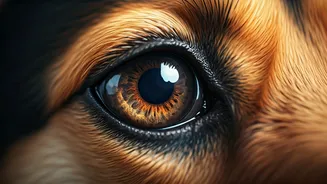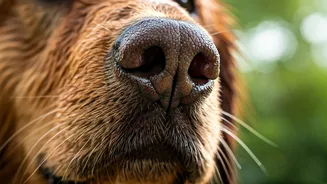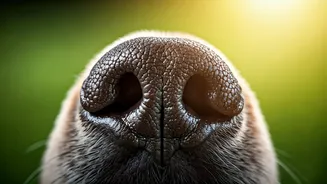Vision Beyond Humans
Dogs, contrary to popular belief, do see color, although their vision differs from ours. Their eyes possess only two types of cones, which enable them
to perceive blues and yellows. Humans, on the other hand, have three cones, granting them the ability to see a broader spectrum of colors, including reds and greens. However, dogs excel in other areas of vision. They boast a wider field of view than humans, typically around 240 degrees compared to our 180 degrees. This wider perspective is highly beneficial, allowing them to detect movement from a greater distance. Dogs also possess superior night vision. They have a reflective layer called the tapetum lucidum behind their retinas, which enhances their ability to see in dim light. This layer reflects light back through the retina, giving the light a second chance to stimulate the photoreceptors. This allows dogs to see much better in low-light conditions, making them well-suited for hunting and navigating at dusk or dawn.
Hearing: Super Senses
A dog's hearing is another remarkable sense, often outperforming human capabilities. They can detect sounds at much higher frequencies than humans can, reaching up to approximately 45,000 Hz, whereas humans typically hear up to 20,000 Hz. This means dogs can pick up the high-pitched sounds we miss, like the squeak of a toy or the ultrasonic whistle used for training. Furthermore, a dog's ears are designed to swivel, providing a crucial advantage in pinpointing the origin of sounds. Each ear can move independently, allowing them to rotate and focus on a particular sound. This feature contributes to a dog's remarkable ability to determine the direction and distance of sounds, making them highly aware of their surroundings. This ability, combined with their superior hearing range, allows them to quickly identify and locate sounds, whether it is the rustle of leaves or a distant call.
Smell: A Powerful Nose
A dog's sense of smell is one of their most famous and impressive capabilities, far surpassing human olfactory senses. The area of the brain dedicated to processing smells is considerably larger in dogs than in humans. Dogs have approximately 300 million olfactory receptors, compared to humans' 5 to 6 million. This substantial difference provides them with a significantly heightened sense of smell. The structure of a dog's nose also contributes to this remarkable sense. The nasal passages are long and complex, allowing them to analyze odors efficiently. As they inhale, a portion of the air flows through a specialized area dedicated to smell, separating it from the air used for breathing. This design allows dogs to simultaneously breathe and analyze scents, making them highly efficient scent detectors. Dogs can also detect a wide range of scents, even in very diluted concentrations, which makes them ideal for a variety of tasks, including search and rescue operations, detecting diseases, and identifying drugs or explosives.
Taste: Flavor Profiles
While dogs don't have as sophisticated a sense of taste as humans, they still experience flavors differently. Dogs have fewer taste buds than humans, around 1,700 compared to our approximately 9,000. Their taste buds are also less sensitive, primarily registering sweet, sour, salty, and bitter flavors. However, they lack the same sensitivity to the nuanced flavors that humans appreciate. The food choices and palates of dogs are heavily influenced by the smells of the food. What seems appealing to a dog is often driven by the aroma more than the taste. Despite their less refined taste buds, dogs still derive pleasure from eating and have a preference for certain flavors. They generally favor foods that are high in protein and fat, which aligns with their evolutionary diet as carnivores. Also, the texture of food and individual preferences play a significant role in a dog's food selection, making their eating habits a combination of sensory perceptions and learned experiences.
Touch: Skin Deep
A dog's sense of touch is crucial for communication and interacting with its environment. The skin, a dog's largest organ, is covered with various receptors that detect pressure, pain, and temperature. These receptors are found throughout the body, providing dogs with a detailed understanding of their surroundings. This includes their whiskers, which are particularly sensitive to changes in air currents and touch. Whiskers help dogs navigate in tight spaces and detect objects without seeing them. They also have a heightened sensitivity to touch in their paws, which helps them to feel the ground. The tactile senses contribute to forming social bonds. Dogs use physical contact, such as petting, scratching, and grooming, to create a sense of closeness and belonging. Physical touch provides comfort, security, and enhances their sense of well-being. Their tactile sensitivity is integral to their understanding of the world, from the texture of a toy to the comforting feel of a human touch.












